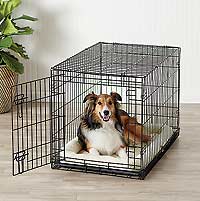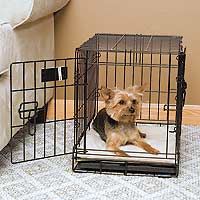Many people see a crate as a jail cell, but if you understand a little about dogs, you know this isn’t true. Most people that work in the dog world i.e. Veterinarians, Trainers and Groomers see the benefits of a dog well versed in crate time. Chances are they’ll tell you their own dog seeks out a crate for naps, at bedtime and whenever they just wants a little me time.
A crate allows you to work with your pet’s natural desire to be a den dweller. Dogs in the wild seek out small, dark, safe spots to inhabit. In fact, if you bring a new dog into your home and you don’t have a crate ready for them, chances are they’ll find a spot, such as under a table or chair or even behind the toilet in the bathroom, which answers their need for a secure, out-of-the-way “den” of their own.
If you leave them in their makeshift den, you’ll notice that they won’t relieve themselves there. That’s because dogs are programmed by nature not to soil their dens. In the wild, nursing wolves and coyotes teach their pups to relieve themselves outside their dens at a very early age. This keeps predators from investigating inside their little homes, and keeps messes outside the sleeping area.
And that is exactly why crates are so useful for dogs that haven’t yet been housetrained. A dog with their own den will not want to soil it, so by providing a crate for them, you’re working in harmony with their natural instinct to keep their little space clean. As long as your dog is getting consistent and frequent breaks, nature will prompt them not to soil their den space in between trips.
Another benefit of crate training is that a dog accustomed to spending time alone in their own den even when you are home is much less likely to develop separation anxiety or other phobias/panic disorders.
Putting a puppy in a crate for a nap or some quiet time also helps them learn not to expect constant attention from human family members. This strategy coupled with basic obedience training will set the stage for a secure, balanced dog.
Sizing a crate for your dog
When you’re purchasing a new crate for your dog, size is important. You want a space that is not too small, but also not too big. Your dog should be able to stand up, lie down and turn around in the crate. It should be large enough to move around in comfortably, but not so large that they can easily use one end as a bathroom and the other end for sleeping and snacking. If you need to housetrain your dog, a crate that’s too large can actually slow down the process.
If you’re unsure what size crate you need, talk to a store employee about the size of your dog and what you want to accomplish, and he or they should be able to help you pick the right size enclosure. If you’re crate training a puppy, especially a medium to large breed dog, keep in mind you’ll most likely need to graduate to a bigger crate as your pup matures.
When you bring the new crate home, place it in an area where your family spends time — not in an isolated spot, outdoors, in a high traffic location, or where your dog will experience temperature extremes. Also make sure there’s nothing inside the crate that could cause harm, including anything around their neck that could get tangled or hung up on a part of the enclosure. 
Getting your dog familiar with a crate
The first rule of crate training is to never, ever force your dog into his crate. You never want to introduce a crate, shove your confused pup into it, close the door and leave. That’s how you wind up with a dog with an unmanageable case of separation anxiety or a pathological aversion to enclosed or small spaces.
It’s also important to try never to pull your dog out of their crate, either. The crate should represent a safe zone for your dog, so you never want to make that safe zone feel unsafe by forcing them into it or out of it.
The second rule of crate training is making the crate positive. In other words, everything about the crate must be a good thing from your dog’s perspective. While you’re getting them used to the crate, everything they love goes in there, including treats, treat release and food puzzle toys, and chew toys. The goal is to have your dog voluntarily go into the crate.
If your pup has had no bad experiences with a crate and you create a safe, dark little den for them inside, they might just go right in voluntarily as soon as you present the new space. But even if they take to the crate right away, you still want to stick with the positive crate rule and put treats, toys and other goodies in there for encouragement.
Crate training a Fearful dog
If your dog is nervous about the new little space or is fearful of it due to a bad past experience, you’ll have to take things slower. A dog who has been crated as a form of punishment or has been locked in a crate for inappropriately long periods will need to be gently and patiently reintroduced to a crate.
Make sure to leave the door to the crate open for a nervous dog. Put food rewards around the outside of the crate and inside as well so they can get comfortable going in and out of the crate without worrying about being “trapped” inside. Move their food and water bowls closer to the crate as another way to associate good things with the crate.
Once you sense your dog is comfortable inside the crate at mealtime, try closing the door as soon as they start to eat. Do it casually, without fanfare. Praise them in a calm, soothing tone and then get busy with something. Chances are they will finish the meal and then realize the door is closed and they are not free to leave the crate.
They may look at you with an expectant or confused expression as if to say, “What’s the deal with the closed door?” You don’t need to ignore that completely, but you should keep doing what you’re doing and stay very calm as though there’s nothing out of the ordinary going on. Your dog may whine or cry a bit, but they should pretty quickly decide to lie down.
I recommend when you first start closing the crate door that you close it only for short periods of time. You’ll also want to leave a toy or treat inside the crate to keep him entertained. After a few minutes, when your dog has relaxed inside the crate, that’s your signal the crate has gone from being a bad thing to a neutral thing for your dog. Open the door so they can once again come and go as they please.
Once your dog is associating only good things with the crate and feels comfortable inside it, you can close the door for longer periods of time. Don’t try leaving your house for short periods until he’s completely comfortable in the locked crate while you’re home.
You can gradually extend the amount of time you leave them in the crate, providing they are getting consistent, frequent trips outside to potty. If you need to leave your dog for longer than four hours, I recommend you use a dog sitter or a doggy daycare facility rather than crating a nervous dog for long stretches. You want them to view the crate as a safe place to rest and be calm, so when they are in there and you’re home, resist the urge to energetically interact.
When you let your dog out of a crate, give them a sit command and plenty of calm praise when they follow the command. Make entry and exit from the crate a calm, neutral experience and unassociated with any of your dog’s behaviors.
Dogs that have regular positive crate experiences handle the stresses of dog life better. When they go to the vet or groomer and are not actively being examined or groomed they will often spend a decent amount of time in a crate. If they see a crate as positive or neutral they typically cope better with all the other aspects that come with these strange, noisy and stressful places.. |